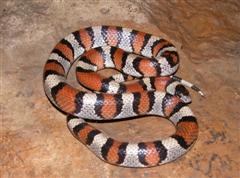Milksnake - Central plains
Central Plains Milk Snake Scientific Name: Lampropeltis triangulum gentilis
Thu, 10th July, 2025 - 1:22 am GMT
Sponsor Ads:

Alternative Name
Central Plains Milk Snake Scientific Name: Lampropeltis triangulum gentilisBasic Info
The Central Plains Milksnake is an average sized, colorful snake. Their coloration of a light body with red, orange, yellow and/or white patches and black-edged brown patches on the side of the body resemble that of the Copperhead or Coral Snake. This adaptation is useful in that it protects them from some prey. They also can be mistaken for the venomous snakes by humans who often kill them without knowing they are harmless. This Milksnake's body is usually gray or tan, often with a Y-shaped spot on the neck. The neck is banded with black. Lighter colored bands separate these bands.
Health
Breeding In the spring, after warming up, milksnakes mate while still in their hibernation groups. The female lays a clutch that contains between 2 and 17 eggs, often in rotting logs. The eggs are elliptical in shape. The eggs hatch after between six and nine week of incubation. The hatchlings average around eight inches in length and are very brightly colored. The milksnake is usually mature at around three or four years of age.Habitat
They most often make their homes near forests, although they will also live in open woodland, prairies, near small streams, on rocky hillsides, on savannahs, and in agricultural fields and other, more urban areas.Behavior
The Central Plains Milksnake is primarily nocturnal and is rarely seen during the day. They are solitary animals, seeking the company of other Milksnakes only during brumation. Directly before and after brumation, they are often seen basking in large groups. The Central Plains Milksnake, like other milksnakes, can do well in a wide range of habitats. They often hunt in barns because of the large rodent populations. When threatened, the milksnake may vibrate its tail against the ground, often sounding much like a Rattlesnake.Origin
North AmericaHistory
N/ACommon Foods
They are valued as wild animals on the farm and in urban areas as they eat mice and other rodents.Sponsor Ads:
"If there is some end of the things we do, which we desire for its own sake, clearly this must be the good. Will not knowledge of it, then, have a great influence on life? Shall we not, like archers who have a mark to aim at, be more likely to hit upon what we should? If so, we must try, in outline at least, to determine what it is." -- Aristotle. Nicomachean Ethics.(I.1094a18). c. 325 BC.
Milksnake - Central plains
Coded by: BGID® | ALL RIGHTS RESERVED Copyright © 2000-2025
Disclaimer | Privacy | Report Errors / Contact | Credits








 President of the United States of America - Real Estate mogul, Pageant owner and now one of the most controversial men in political history.
President of the United States of America - Real Estate mogul, Pageant owner and now one of the most controversial men in political history.  Global warming has been in and out as the "latest" hot topic for many years. It is, according to modern scientists, the result of man-made industrial pollutants, clearing forested areas, agriculture, etc. But now they are thinking it started way before the Industrial Revolution...
Global warming has been in and out as the "latest" hot topic for many years. It is, according to modern scientists, the result of man-made industrial pollutants, clearing forested areas, agriculture, etc. But now they are thinking it started way before the Industrial Revolution...  Politician, US Vice President and President of the USA - Joseph Robinette Biden Jr.
Politician, US Vice President and President of the USA - Joseph Robinette Biden Jr.  versus
versus  Russia: 'The Evil Empire'? Are they all that bad or is it just the USA trying to portray Russia as bad because they are a world power with land bigger and a society very different from the USA ideal?
Russia: 'The Evil Empire'? Are they all that bad or is it just the USA trying to portray Russia as bad because they are a world power with land bigger and a society very different from the USA ideal? 
 Corona virus
Corona virus 
 Users with wide screen monitors can benefit from more content on every page.
Users with wide screen monitors can benefit from more content on every page.